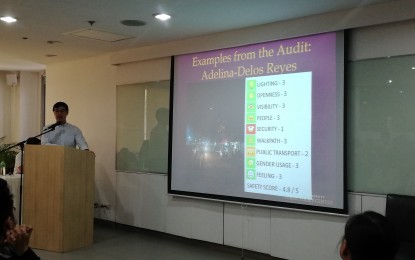
Transport planner Robert Anthony Siy III presents the result of a safety audit conducted under the Safe Urban Mobility Project showing that streets at the University Belt in Manila are relatively safe for students. (PNA photo by Aerol John B. Pateña)
MANILA -- Streets along the so-called University Belt (U-Belt) in Manila are "relatively safe" for students, a study done by the Far Eastern University Public Policy Center (FEU-PPC) shows.
According to the FEU-PPC's Safe Urban Mobility Project, key areas in the U-Belt have high safety levels, particularly during nighttime.
During a forum on urban safety held at the FEU campus in Makati City Thursday, transport planner and economist, Robert Anthony Siy III, said factors that affect the high safety scores include pleasant, traditional urban design in the study area, particularly at the arcade walkways; pedestrian crossings that improve foot traffic; and regular presence and activity of public transport, even late at night.
“The audit shows a majority of high safety scores indicating that the study area is safe, contradictory to the usual impression that the U-Belt area is unsafe,” Siy said.
The study noted a disparity between the assessment of the male and female participants on safety levels in areas at the U-Belt.
“Female auditors gave lower safety scores compared to male auditors, which follows that danger and risk are generally pressing concerns for women. This was most apparent with the ‘Lighting’ parameter, indicating that women need to observe higher levels of lighting than men in order to rate an area as safe,” Siy said.
The project also noted that areas in U-Belt posted low scores in the "Security" parameter due to lack of visibility of police and other security personnel.
“One of the lowest safety indicators in the study is the lack of security. We still need to conduct a more in-depth study of the areas for validation,” Siy said.
He clarified that the results of the project should not be perceived by the public as a definitive claim that the U-Belt is safe, as he stressed that it is still a "work in progress."
“What we can say is that based on our audit, a certain area may be high, based on certain parameters. What can be reported is there are certain parameters that an area might have low scores while they are higher in others. We want to identify what certain areas are needed to be improved,” Siy said.
Urban planner, architect Paulo Alcazaren, urged the government to enforce security measures, such as ensuring that sidewalks being used by students and pedestrians have adequate lighting and cleared of illegal vendors and other obstructions.
“In other countries, the government always provides safe spaces for cars, safe sidewalks for pedestrians but we don’t have the same thing. (The) government cannot be absolved of their responsibility to provide safe streets and sidewalks (that are) well lit,” Alcazaren said in an interview with reporters on the sidelines of the forum.
The research was undertaken by FEU NSTP students, accompanied by the university’s security and medical personnel, on the evening of February 12 in the following areas: CM Recto, Quezon Blvd., Lerma St., Nicanor Reyes St., Morayta, SH Loyola, Plaza Miranda, Quiapo, España Blvd., P. Paredes, R. Papa and Legarda. The participants consisted of 41 male students and 19 female students.
The audit used the MySafetiPinApp, a map-based mobile application that collects and disseminates safety-related information through the crowdsourcing scoring method based on nine parameters: lighting, openness, visibility, people density, security, walk path, transportation, gender density, and overall vicinity feel.
The FEU-PPC said it would further enhance the coverage and scope of its project to come up with a comprehensive assessment of the security situation at the University Belt where several universities, such as the University of Santo Tomas, University of the East, National University, FEU and others, are located.
It will publish a final report providing detailed proposals on ensuring urban safety by May and establish partnerships with government and U-Belt stakeholders. (PNA)
